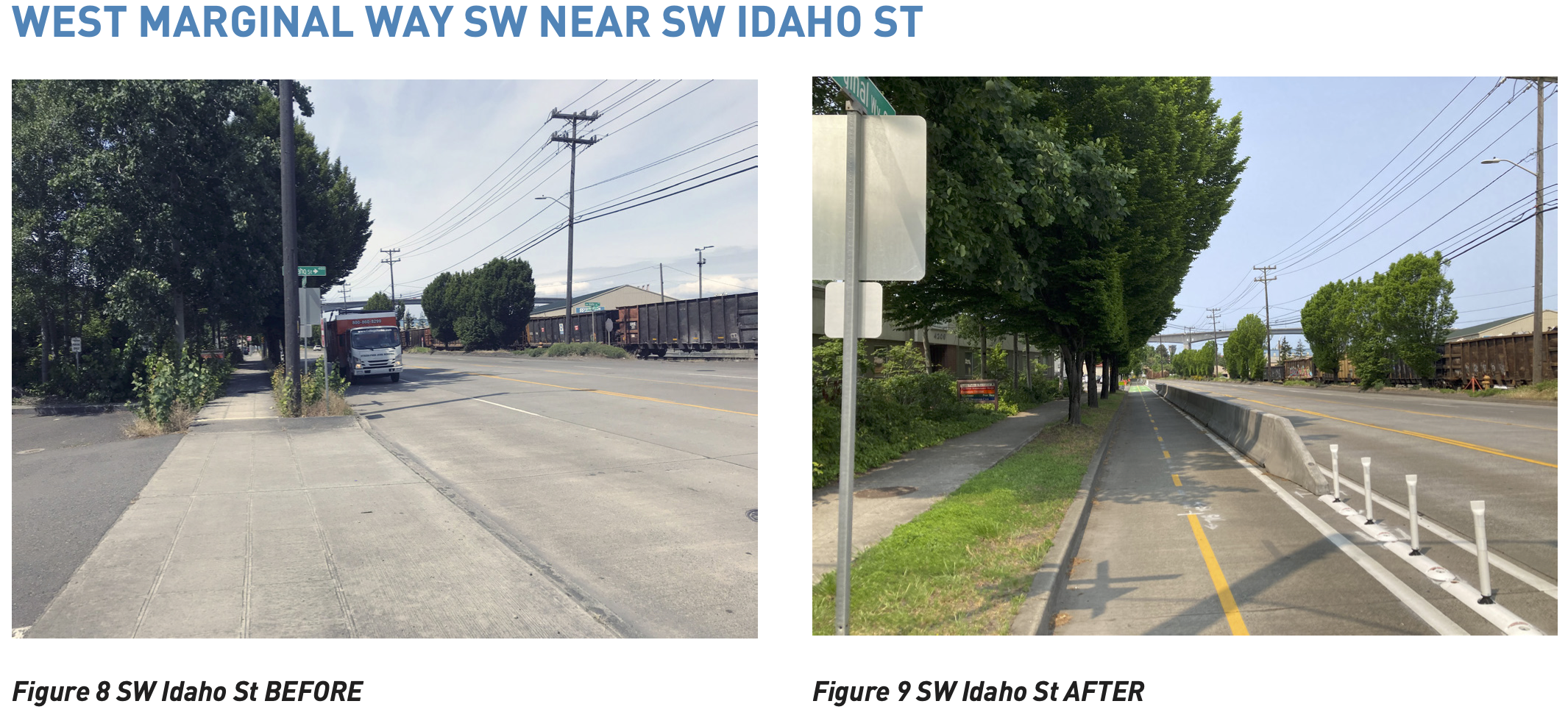SDOT: Weekday biking up 144% after Duwamish Trail connection, freight travel times increased less than 1 second
 From the West Marginal Way SW Safety Project Evaluation Report (PDF).
From the West Marginal Way SW Safety Project Evaluation Report (PDF).The Freight Advisory Board fought hard against SDOT's plan to connect the Duwamish Trail to the Alki Trail and Spokane Street Swing Bridge, a connection sorely needed since many sections of the trail opened in the early 1990s. But after Mayor Jenny Durkan delayed the project, safe streets advocates kept pushing. Mayor Bruce Harrell and his then-new SDOT Director Greg Spotts then made the trail link a priority, building a temporary connection during the January 2023 emergency closure of the Spokane Street Swing Bridge that they then kept in place until a permanent trail connection could be completed later that spring.
In response to concerns about the bikeway causing traffic and freight mobility issues, SDOT conducted a study. And the results are in: The trail increased weekday biking by 144%, weekend biking by 53% and walking by 90%. And this all happened while increasing travel times for cars and trucks by less than one second, a literal blink of an eye.
The thing is, these results should not be a surprise to us in 2023. We've done this song and dance for more than a decade now. Results like these happen every time the city completes a significant safety project on a fast and over-designed street like W Marginal Way. People worry that the project will increase traffic and complain loudly, unconvinced by assurances from SDOT's staff that travel times will not increase significantly. Then the city completes the project and finds that, sure enough, SDOT staff was correct all along. It's almost like the people SDOT has hired to design safer streets know what they're doing. Here's a likely non-exhaustive list followed by the date of the study (typically a year later):
- Stone Way (2010 study)
- Fauntleroy Way (2010 study)
- Nickerson (2012 study)
- NE 125th St (2013 study)
- NE 75th St (2015 study)
- Rainier Ave (2016 study)
- NE 65th St (2020 study)
- W Marginal Way (2023 study)
Will the Freight Advisory Board learn from this experience and evolve their understandings of how our streets can be both safer and still support freight movement? I sure hope so, because we've got a lot of work to do and could use their help in our city's fight to reduce our terrifying increases in traffic deaths in recent years, many of which have occurred on major truck streets. My advice for the Freight Board as someone who has observed these advisory boards in action for more than a decade would be that they should focus their efforts on the specific needs of freight movement in city street designs rather than on a misguided idea that more lanes is always better for freight. We know this to be untrue, and holding onto counting lanes as a freight mobility goal makes them look hopelessly outdated. They also do the freight community a disservice when they choose to fight the wrong fights. For example, the Board spent years fighting this trail on W Marginal Way only to discover that they were fighting over travel times equivalent to a blink of an eye. That work did not help the freight community, but it did delay this trail connection for years and alienate a bunch of people who they may want as allies in the future. Going forward, they should be partners in safety by encouraging protection for people walking and biking as well as safer street designs that reduce speeding, make turning movements safer and easier, and improve visibility between all road users. Those goals do help freight operators, and they align with the work of the other advisory boards. The Freight Board could then use their specific expertise and real-world knowledge to help SDOT staffers understand how truck drivers will use their proposed designs and point out potential problem spots that need further analysis.
The controversy surrounding SDOT's safe streets work should not be the imagined traffic backups in the minds of people who refuse to believe an SDOT safety program that has been exactly correct about the efficacy of their work for more than a decade. The controversy should be that we have all these studies showing that we know what to do to make our streets safer but we aren't repeating this success on every dangerous street before more people are injured or killed.